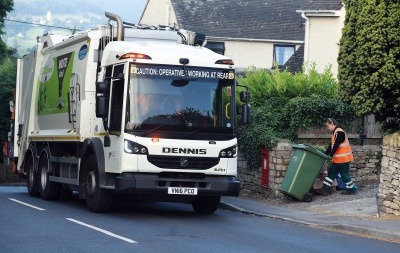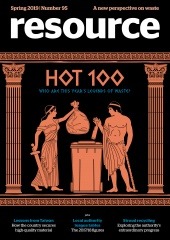Doing themselves Stroud: Maximising the benefits of fortnightly collections
Following Stroud District Council’s incredible increase in its recycling rate over the last two years, Dr Sarah Kemp, Junior Modeller at Eunomia Research and Consulting, explores whether its approach to waste provides a model for other councils to replicate
The headlines on the recycling rate data released in December understandably focused on the continuing flatlining of England’s collection performance. On one measure, ‘waste from households’, the recycling rate for 2017/18 fell by 0.3 percentage points to 44.8 per cent, leaving the EU’s 2020 target of 50 per cent looking increasingly distant.
That disappointing result rather overshadowed the areas of good news: at a national level, total waste from households in England went down by 2.3 per cent, while at a local level there were some striking improvements. Stroud topped the ‘most improved’ league table for a second year in a row: back in 2015/16, its recycling rate was 31.5 per cent; by 2017/18 it had risen to 61.2 per cent, almost doubling in just two years. If we can understand how Stroud made such rapid progress, perhaps that elusive 50 per cent target might still be within reach.
Material difference
How did Stroud do it? A range of different material streams have contributed to the increase. Until 2016, Stroud was one of the few councils that did not offer a garden waste service; its charged collection scheme has gradually grown in popularity, but still contributes less than 100 kilogrammes (kg) per household per year – making it a far smaller share of Stroud’s recycling than it is for
some councils.
 A greater proportion of the increase is due to the food waste service introduced in November 2016, which accompanied a switch from weekly to fortnightly residual collections. The service change also led to an uptick in dry recycling rates. Following its implementation, residual waste arisings have almost halved reducing by more than the recycling tonnage has increased.
A greater proportion of the increase is due to the food waste service introduced in November 2016, which accompanied a switch from weekly to fortnightly residual collections. The service change also led to an uptick in dry recycling rates. Following its implementation, residual waste arisings have almost halved reducing by more than the recycling tonnage has increased.
Comparing the 12 months before the change with the 12 months after the change, Stroud’s kerbside tonnage reduced by 3,500 tonnes. So, could all authorities replicate Stroud’s impressive achievements by making similar changes?
Under no illusions
Well, many other authorities have already gone fortnightly – according to the Waste and Resources Action Programme (WRAP), 77 per cent of councils collect residual waste every two weeks from at least some of their households. But few have had performance boosts similar to Stroud’s. Sutton, for example, introduced a fortnightly residual service and weekly separate food waste service in April 2017, and saw its recycling rate increase by 13.5 percentage points between 2016/17 and 2017/18. That was enough to make the authority the second most improved in the recent waste statistics release – a fantastic achievement, but miles behind Stroud’s 30 percentage point increase over two years.
Recent Eunomia benchmarking exercises (using the Benchmarker tool) have shown that moving from weekly to fortnightly residual and adding a food waste service typically adds around 10 percentagepoints to an authority’s recycling rate, assuming no waste displacement.
In Stroud’s case, there also appears to have been a significant waste prevention effect. We should first explore whether Stroud’s exceptional statistics might somehow be illusory. Are residents responding to the new residual waste restrictions by putting non-recyclable material in the recycling? It appears not.
The data shows only a small increase in recycling rejects at the MRF, from three per cent to five per cent, around 3kg per household per year (kg/hh/yr) more. That’s around one per cent of the reduction in residual waste.
In some areas with fortnightly residual waste collections, enterprising commercial waste collectors have sold residents ‘top up’ residual waste collection services, making waste disappear out of the local authority statistics. I’ve found no evidence of such services being offered in Stroud, though.
A frequently raised fear is that reducing residual collection frequency leads to fly tipping. Stroud saw a small increase (79 tonnes) in the annual fly-tip tonnage, but this was more than compensated for by a decrease in collected street cleansing waste (151 tonnes) over the same period.
Did people take their excess waste to the HWRC instead? Gloucestershire County Council is responsible for the HWRCs in the area, which makes it difficult to isolate Stroud’s impact; however, the county’s HWRC tonnage is almost unchanged across the two years since Stroud made its service alterations. There doesn’t appear to be any plausible explanation other than a genuine decrease in residual waste, over and above the increase in recycling.
Weight loss
The decrease in residual waste is striking: Stroud’s yield for 2017/18 was just 259 kg/hh, which is the smallest of any authority in England, including those authorities that have three-weekly residual collections. Three-weekly residual collections may be a great way to reduce residual, but does Stroud’s example show that they are an unnecessary step?
Stroud may not have gone three weekly, but residents have still had a significant ‘squeeze’ on residual waste capacity. Formerly, residents could dispose of as many sacks of residual waste as they liked each week. As part of the service change, Stroud introduced 140-litre wheeled bins; collected fortnightly, that provides households with an equivalent volume of 70 litres per week. A 240-litre wheeled bin, the most popular choice for these restricted collections, provides 80 litres per week over three weeks – so Stroud residents actually have a smaller weekly volume available.
However, this isn’t a cheap option for cash-strapped councils. In an authority of 50,000 households, the capital outlay for new bins would be around £1 million – a major investment. Changing collection frequency while keeping the old bins is typically a cheaper option for those looking to squeeze residual waste capacity.
Keep calm and caddy on
Even taking account of the squeeze on residual waste capacity, Stroud’s results are remarkable. The council’s food waste yields, at 110kg per household, are higher than any other authority in England achieved in 2016/17. Residual frequency tends to be a strong driver of food waste diversion, so beating the performance of authorities with three-weekly residual collections is a major achievement.
During the first week of collections, around 90 percent of households were putting their food waste recycling out for collection. This is incredibly high for a fortnightly residual service, with many authorities only achieving around 50 per cent participation. Nor does Stroud provide free caddy liners, something that usually encourages participation.
However, residents are allowed to use their own plastic bags, as well as caddy liners, to contain their food waste, as the recycling facility is geared up to debagging the waste before it is processed. In itself though, this relatively common policy is unlikely to account for the incredible participation rates.
Could this strong participation have been a result of amazing communications? Let’s look at another recent successful campaign for comparison. Bristol City Council has long offered a food waste collection, but recently started allowing householders to use plastic bags to line caddies. The change was announced, alongside a range of measures aimed to encourage food waste recycling, through a communications campaign. The result was a significant success, resulting in a 16 per cent increase in collected food waste, but set-out rates and total yields remain way below Stroud’s.
 This article was taken from Issue 95
This article was taken from Issue 95Eunomia has a database showing the effects of different initiatives to increase food waste captures, such as bin stickers, communication campaigns and free caddy liners. It shows that, unsurprisingly, a combination of measures produces the best outcome, with bin stickers being particularly effective. But none of the examples has produced anything close to Stroud’s result.
A final possibility is that people in Stroud are unusually green-minded or motivated to recycle.
Certainly, a relatively high proportion of district councillors (nine out of fifty, or 18 per cent) are from the Green Party – but that’s about the same as Bristol (thirteen of seventy, or 19 per cent), which has a lower recycling performance. Perhaps the contentious debate over the Javelin Park incinerator, now being built within the district to meet the waste disposal needs of the whole county, has made people more determined to avoid producing residual waste – but that debate pre-dates the new service, and its impacts are hard to measure, let alone replicate elsewhere!
Clearly, no single factor – container size, collection frequency, caddy bag policy or communications – is responsible for the incredible results in Stroud. However, the message to other authorities seems clear. Reduction in residual collection frequency and container size, a convenient recycling service and excellent communications campaigns are key. And the speed of progress in Stroud suggests that, just maybe, there’s still a chance for England to make that 50 per cent target.
This article is a version of one that originally appeared on the Isonomia blog. For more, visit www.isonomia.co.uk




